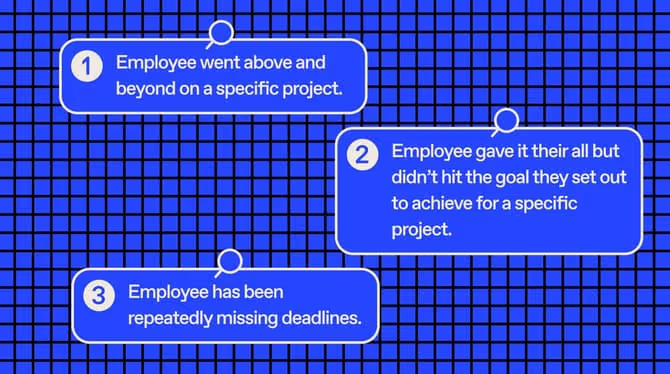10 Tips for creating a feedback culture in the workplace

Discover Workleap Officevibe's benchmark report on 12 key employee engagement metrics

Feedback is an essential component of any successful workplace. It creates an opportunity for continuous learning for both managers and employees. The more comfortable and encouraged everyone feels with expressing feedback, the more it empowers each team member in their development.
Building a positive culture requires consistency, initiative, time, and the right mindset! But if boosting employee engagement, decreasing turnover, improving corporate communication, and increasing overall productivity sound good, then building a solid feedback foundation is essential.
What is a workplace feedback culture?
Feedback culture refers to a workplace where the focus lies on open, honest feedback between employees, management, and executives. Everyone may give and receive feedback, from company newcomers to the top leaders in an organization. That includes positive feedback, negative feedback, constructive feedback, etc.
Sharing regular, honest feedback creates a growth mindset in the workplace. It encourages employees to learn, grow, and seek new challenges.
{emphasize}
A healthy feedback culture is also important because it:
- Establishes a positive workplace
- Improves communication skills among employees
- Provides critical performance metrics and business insights
- Creates opportunities for professional development
- Increases employee engagement levels
{emphasize}
10 Tips for building a healthy feedback culture in your team
Building a strong workplace feedback culture requires time and effort, but it's worth the payoff. As a leader, prioritize frequent and continuous feedback conversations to show your team that you care about the people behind the work. It gives them attention, creating trust between the manager and team members.
While there are no shortcuts to shifting corporate culture, these tips can help make the transition smoother.
1. Make giving and receiving feedback a habit
Periodic feedback, such as annual performance reviews, aren't enough to build a strong feedback culture. Employees and managers need to get used to giving and receiving feedback. Practicing these skills regularly with shorter monthly meetings, weekly check-ins, or informal chats will make exchanging feedback more natural.
Managers should do their best to be available to talk with employees regarding performance, potential issues, and day-to-day operations, both in group and one-on-one meetings. This type of open-door policy becomes increasingly valuable as your team starts to get used to delivering effective feedback to their leaders.
Depending on the scenario, face-to-face meetings can be the preferred method to deliver regular feedback; alternatively, you can also use short surveys to get a snapshot of the current workplace sentiment. Officevibe's Employee Feedback Tool contains weekly employee Pulse Surveys and multiple feedback channels to get employees used to the idea of giving feedback.

2. Create a judgment-free feedback zone
Every employee should feel comfortable and safe during the feedback process. So how can you foster an environment where continuous feedback is the norm?
Every manager should offer a safe space for employees to share open feedback or give critical feedback without repercussions. A judgment-free culture will result in employees being more willing to speak up, express themselves, and feel engaged to grow with the organization.
If an employee feels uncomfortable giving feedback and sharing constructive criticism with others, offer the option of private, anonymous feedback sessions. Officevibe's Pulse Survey Tool is a powerful resource for getting anonymous feedback from employees, which may give employees the confidence they need to provide useful and genuine feedback.
3. Celebrate team accomplishments with positive feedback
To create a healthy culture with continuous feedback, celebrate your team's successes and accomplishments. Productivity and employee engagement will soar when everyone feels those good vibes from crushing it at work.
{emphasize}
🔍 We spot an opportunity
Officevibe's data report on The State of Employee Experience revealed that 25% of employees say that their organization doesn't celebrate accomplishments or learnings.
Upping your recognition and feedback game is a low-cost initiative with a high impact.
{emphasize}
Team meetings are a great way of celebrating team successes. By giving good feedback and reinforcing positive behaviours, your team feels valued and recognized for their achievements and is more likely to put more effort into the next project.
[ov_cta id="5116629"]
4. Have systematic feedback mechanisms
The best way to get consistent feedback is to incorporate feedback tools into the systems you and your teammates use daily. If you have weekly check-ins, put in a "feedback" point in the form, making it a routine part of the process, and allow each person to evaluate their own and others' performance.
Pulse Surveys, such as those found on the Officevibe platform, can also inform the topics for discussion during these check-ins.
An excellent way to identify a team's strengths and weaknesses is to conduct a debriefing team meeting at the end of every major project. While members may initially be reluctant to dissect the challenges they faced in a project, by keeping the feedback constructive, teams will eventually view these meetings as valuable instruments for improvement, especially when combined with positive feedback regarding their accomplishments.
5. Hold open team discussions and honest feedback sessions
Holding group discussions encourages employees to share open, direct feedback with each other and their leaders. Use these meetings to strengthen bonds and normalize feedback in the workplace. Some teams find that giving group feedback makes it easier to provide feedback to direct reports, as they have the necessary backup from their cohort.
Building strong feedback shouldn't be limited to manager-employee exchanges.
While open group discussions have many benefits, some individuals may find them intimidating and uncomfortable at first. It's vital not to force feedback and instead lead by example. Guide everyone in the meeting to give necessary, helpful, and kind feedback.
6. Provide feedback training
Receiving and giving feedback is a skill. Very few positive feedback cultures spring up without some form of training that shows both leaders and workers how to provide useful and informative feedback. Incorporating this type of training is the first step toward building a positive feedback culture in the workplace.
Feedback training can encourage employees to view feedback as a two-way street. They should feel comfortable giving and requesting feedback, whether it's during performance reviews, group discussions, or during weekly sessions.
{emphasize}
While formal training tends to be the best option, here are ways you can give your employees valuable feedback training yourself:
- Offer guidance on the do's and dont's of giving and receiving feedback
- Demonstrate how to give and receive corrective feedback tactfully
- Teach employees to give and share feedback that's clear and solution-oriented
{emphasize}
{emphasize}
🔥 Officevibe's comprehensive guide to employee feedback offers more tips, examples, and best practices for managers who want to level up their feedback skillset.
{emphasize}
7. Provide real-time feedback
Real-time feedback refers to providing feedback almost immediately after a particular behaviour. It can refer to negative feedback that notes when someone makes a mistake or positive feedback praising an employee for their stellar performance.
The benefits of adopting real-time feedback are tangible in employee performance. It emphasizes personal accountability, particularly when employees know they will receive a review directly after their performance rather than three months later.
It also helps everyone correct issues as they arise. Instead of waiting until the next performance review to correct someone's behaviour, immediate feedback allows you to fix the problem without watching the individual repeatedly make the same mistake.
Similarly, employees who see their work recognized while still fresh will be more motivated to improve their game and continue to put in the concerted effort.
8. Conduct one-on-one meeting follow-ups
To create a feedback-oriented culture, follow up with every person after weekly feedback sessions. Conducting follow-ups lets managers build meaningful, authentic relationships with every worker. It tells your team that you value their feedback and genuinely care about their wellbeing and work performance.
A company that wants to create a strong feedback culture needs to focus on actually hearing and implementing the feedback it gets. An employee may feel comfortable offering advice, but if the organization doesn't take this feedback seriously, the employee will start feeling unseen.

9. Lead by example by giving feedback
As a manager, lead by example to foster a growth mindset in the workplace. Show that feedback culture matters and that you're serious about its implementation. Employees under your management will look to you as a role model and emulate your actions and behaviour. They'll evaluate how well you receive feedback and constructive criticism.
When colleagues see you adopting a strong feedback culture, they're more likely to align and share your goals. Set precedents of immediate, continuous feedback and demonstrate how to take criticism gracefully and apply critiques.
{emphasize}
🌊 Dive deeper: Gain applicable insight with these 15 impactful examples of employee feedback.
{emphasize}
10. Set clear expectations
Maintaining a thriving, feedback-oriented company culture involves setting clear expectations for your employees. Mixed signals and wishy-washy language are not conducive to a productive work environment.
{emphasize}
Exhibit healthy feedback principles in your organization:
- Give employees concise information and actionable advice.
- Explain your expectations regarding feedback frequency, honesty, and participation.
- Discuss all the positive benefits while creating firm boundaries for people who don't participate.
{emphasize}
{emphasize}
🧠 Pro tip: Brainstorm creative ideas regarding a company-wide feedback infrastructure. Having your staff vote on the final decisions makes employees feel invested in the project's success.
{emphasize}
Why creating a feedback culture matters
Feedback culture consists of continuous conversations.
Regular, brief conversations allow leaders to:
- set expectations for the upcoming week
- review priorities
- comment on recent work
- provide course correction when required
- receive feedback
- share important new information
Here at Officevibe, the approach to performance management calls for every team leader to check in with their people once a week.
Why?
Because research has shown that if a leader checks in less often than once a week, the team member's priorities may become vague and less motivating.
It means you, as a leader, can't be as helpful—the conversation shifts from coaching short-term work and current priorities to giving employee feedback about past performance.
Continuous conversations clarify each team member's expectations, what great work looks like, and how everyone can do their best to reach collective goals and objectives.
Testing this approach shows a direct and measurable correlation between the frequency of these conversations and the engagement of team members.
Creating a feedback culture is your route to building an engaged team.
{emphasize}
Curious how Officevibe can help pave the way for more meaningful conversations? Learn more about our in-app feedback messaging, feedback guidance, and a list of other tools that can help you better understand your people's needs.
{emphasize}
Give HR and managers the clarity, confidence, and connection to lead better every day.


%20(1).avif)


.avif)
.avif)
.avif)







.avif)